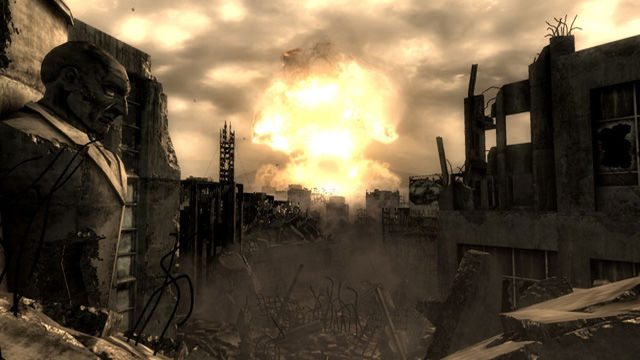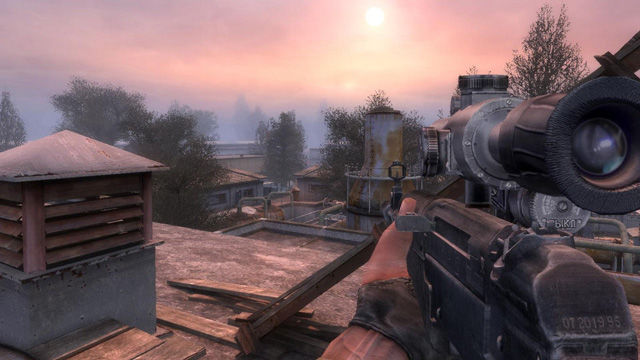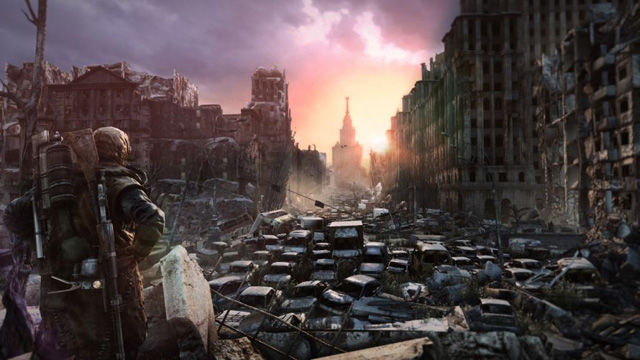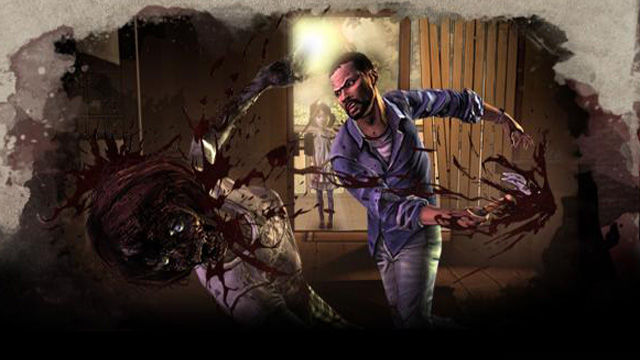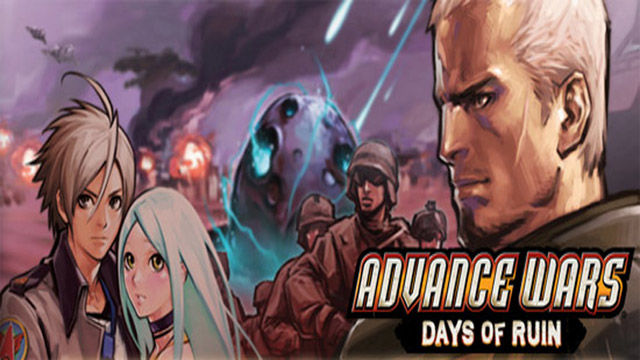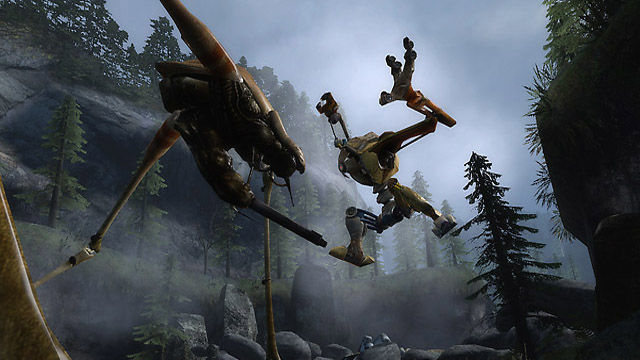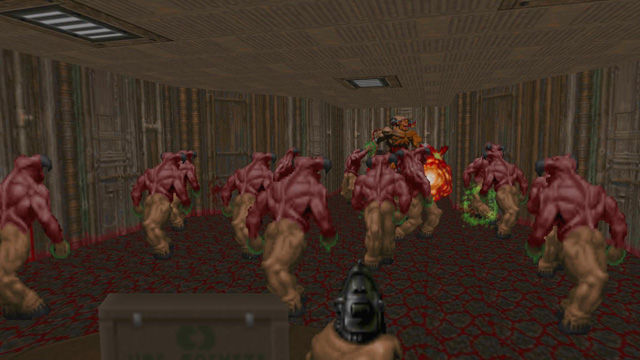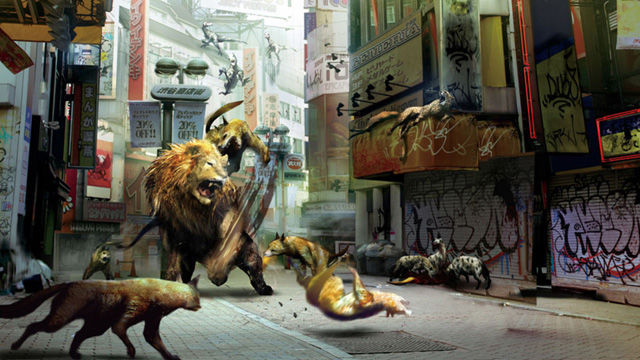Nuclear Annihilation:
Nuclear genocide, on top of being a spectacular and dramatic way to end the world, offers designers a lot of opportunities to construct interesting settings and antagonists to populate their devastated worlds. Shattered cities, hideous mutants, cratered landscapes: these are the hallmarks of a great post-nuclear wasteland, and some of the features that make them so appealing to (virtually) inhabit.
Fallout 3
Fallout takes the idea of a nuclear apocalypse and wrinkles it significantly with its retro-futuristic aesthetic, presenting a future vision of our world that has endured an apocalypse in our past. It’s the intersection of advanced technology with 50’s sensibilities and design that makes the world of Fallout so unique and engrossing. Couple that bizarre mash-up with the desolation and mutated monstrosities of the Fallout wasteland and the often paranoid, insular factions that have seized control of it, and you’ve got a setting that players are happy to while away hundreds of hours in.
S.T.A.L.K.E.R.; Shadow of Chernobyl
While not technically a global apocalypse, the S.T.A.L.K.E.R. franchise drops players into the heart of a vast exclusion zone created after a second catastrophic nuclear event at the Chernobyl power plant in Ukraine. Within this blasted, irradiated dead zone, mercenary “stalkers” scour dangerous anomalies for artifacts that can be traded on the black market for massive profit.
S.T.A.L.K.E.R. makes excellent use of some of the best tropes of a nuclear post-apocalypse and layers on some of its own. Players have to navigate not only massive levels of radiation and mutated wildlife, but also the physics-bending effects of the second catastrophe, dangers that border on the paranormal.
Metro 2033
The distinctly Eastern European apocalypse of Metro 2033 stands out from other nuclear holocausts in that the survivors aren’t striving to rebuild on the surface, which has become a poisonous, uninhabitable waste, but have been driven instead into the dank tunnels of the Russian subway system. Metro seems to rejoice in trapping gamers in dark, claustrophobic spaces with vicious mutants, and does an excellent job of imparting the sense that mankind is being actively hunted by the horrific offspring of its own hubris.
Zombie Apocalypse:
A good zombie apocalypse affords storytellers the opportunity to highlight that age old truism: in any apocalypse, the most dangerous threat is other people. Zombies are often used not as a direct threat to the protagonists, but to corral them into tight spaces with limited resources and let human nature run its course (usually to disastrous effect). The best games that turn on the zombie axis work this angle effectively AND give us hordes of mindless enemies we don’t have to feel bad about shooting in the face.
The Walking Dead
The Walking Dead is one of the best examples of “the real enemy is man” from the last decade. The most hostile and deadly foes Lee and his “friends” square off against aren’t the shambling masses of undead, but rather the other people they welcome into their ragtag band of survivors. It also features some of the best examples of revitalizing the “member of the group was bitten and will inevitably turn” cliché in recent memory. Kudos to Telltale for not only making a fantastic zombie story playable, but making player choice deeply meaningful.
Meteor Strikes:
A number of games opt to take responsibility for the end times out of our hands and assign it to a catastrophic natural event. This serves to remind us not only of the power and volatility of nature, but also, in the case of an apocalyptic meteor strike, the vastness of the universe and our miniature role in it.
Advance Wars: Days of Ruin
Days of Ruin is a bit of an edge case, in that it actually combines multiple apocalypses. Though the chief problem is the series of deadly global meteor showers, after the space rocks have wrought their havoc a lethal disease also begins to devastate the survivors. Days of Ruin shows us how an interesting franchise can be further improved and evolved with the introduction of an apocalypse; it gives us the dark, post-modern Advance Wars we never knew we wanted but absolutely loved.
Rage
Rage gives us a barren, desert world decimated by the impact of asteroid 99942 Apophis, but not before enterprising scientists devised a number of arks to preserve humanity. We’re shown a rare window into an apocalypse where humanity was able to see its end looming and prepare accordingly; naturally, however, it didn’t play out as well as was hoped, and the resulting landscape is just as plagued by bandit warlords, devastated, and resource strapped as most of the other games on this list. Rage is interesting because it illustrates how poorly the best laid plans can go when confronted with the end of the world, and also because it shows us how humanity would soldier on even despite these setbacks.
Alien Invasion:
An apocalyptic invasion by hostile aliens shares some of the merits of a zombie apocalypse: it provides an enemy we don’t have to feel remorse about massacring. It gives writers the opportunity to explore themes like xenophobia and oppression in a safer context than directly broaching nationalism, racism, or other issues that are much more controversial than slaughtering hordes of hostile nonhumans.
Half-Life 2
The Half-Life series introduces an interesting quirk in the standard alien invasion plot: in the world of Half-Life, it was mankind who brought the aliens to earth. After a scientific experiment at a compound in New Mexico goes awry, a “resonance cascade” is triggered, and aliens being to pour through the resulting dimensional rifts. Oddly, this isn’t the invasion that ends in humankind’s near extermination and enslavement. All of this unusual inter-dimensional activity draws the baleful gaze of the Combine, another alien species, which subjugates the human race through the use of overwhelming force and advanced technology.
Half-Life 2 does an excellent job of showcasing a post-apocalypse dystopia, where humanity is shackled and enslaved by inhuman creatures harvesting us and our planet. It allows gamers to fill the shoes of a desperate freedom fighter who is humanity’s last, best chance for freedom, and gives us a version of that ultimate power fantasy: saving the world. Sadly, it also ends on a bit of a cliff-hanger, so we’re left waiting for Valve to grace us with a sequel to finish the fight.
The Hordes of Hell:
There are few better apocalypses than the one described in Revelations. If nothing else, the Bible gives us a great palette to paint the world in mayhem and destruction, and there are few things more terrifying than legions of demons pouring into the world and bringing hell on their backs.
Doom II: Hell on Earth
The sequel to one of the most influential shooters of all time brought the battle in Hell to our doorstep. It’s one thing to fight devils and demons on their own plane, but much more terrifying is the prospect of those same demons entering our world with carte blanche to wreak havoc. Doom II was so wildly successful not only because it gave us the excellent combat and host of monstrous hellbeasts from the original, but because it made the fight personal and the stakes much more dramatic.
The Inexplicable:
Sometimes a game design calls for an apocalypse that can’t (or shouldn’t) be readily explained. In many of these cases, explaining the cause of the apocalypse would dispel a lot of the intrigue and mystery of a setting, or sometimes the only explanation that fits would be so patently ridiculous it’s best avoided altogether.
Tokyo Jungle
Tokyo Jungle wants to show us a future version of Tokyo where humanity has completely vanished, a city that has the qualities of an actual jungle, overrun by animals who are now its masters. Why and how has humanity disappeared? It doesn’t matter. That question is much less important than the vision on offer here, and the game at the core of it. If anything, the question of humanity’s fate serves as a background mystery to prop up the central conceit. The survival mode makes excellent use of this vagueness and focuses on the best parts of the game: the parts where you’re an animal running around the ruins of Tokyo, free from human harassment.
Sadly, in the story mode, Tokyo Jungle delves far too deeply into humanity’s disappearance, and the fumbling mish mash of time travel and environmental collapse (and robot dogs) that the game employs to explain the apocalypse leaves us with an important lesson: a mystery is almost always better than its solution.

